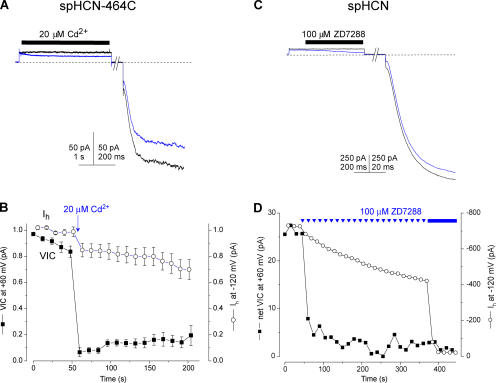Figure 4.
VIC can be blocked independently of Ih. (A) Current traces recorded from a patch expressing spHCN-464C in response to repeated voltage steps to +60 mV and −120 mV. The black trace is the current in the presence of 100 μM cAMP, the blue trace shows the rapid reduction in VIC as 20 μM Cd2+ was applied for 5 s, as indicated by the black bar. (B) Average time course of block of VIC and Ih in spHCN-464C after a single 1-s application of 20 μM Cd2+ at +60 mV (arrow) in the protocol illustrated in A, with voltage steps given every 12 s. The zero baseline for VIC was taken as the minimum current after Cd2+ application. Currents were normalized to the maximum current before Cd2+ application. Little recovery of VIC occurred during ∼2 min of repeated pulsing and washing. (C) In the constant presence of 100 μM cAMP, 100 μM ZD7288 was applied to a patch containing spHCN channels during a voltage pulse to +60 mV. Shown are a trace before the application of ZD7288 (black line) and the first trace where ZD7288 was applied (blue line). After a holding period of 8 s at +10 mV, during which all the ZD7288 was washed from the bath, the channels were then stepped to −120 mV to assay the blockade of Ih (note that the block of VIC is also apparent from the initial current at −120 mV, after ZD7288 has been removed). (D) Time course of block of VIC and Ih in response to repeated applications of 100 μM ZD7288 at +60 mV using the protocol illustrated in C, repeated every 15 s. The plotted symbols for VIC represent the current at the start of each pulse to +60 mV, before application of ZD7288; this isolates the irreversible component of block. Complete blockade was elicited after ∼5 min by changing to constant application of ZD7288 (solid bar). Note that no further block of VIC occurred. Net VIC was calculated by subtracting the lowest current measured after blocker application.

